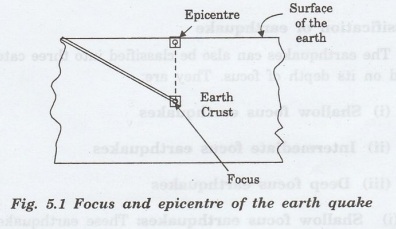Physics For Civil Engineering: Unit V: Natural Disasters
Earth Quake Ground Motion
Basic Concepts, Estimation Techniques, Definition, Causes, Types, Classification, Effects of earthquake
The earthquake is caused by a portion of the rigid crust of the earth giving way or getting fractured, some distance below its surface.
EARTH QUAKE GROUND MOTION – BASIC CONCEPTS
AND ESTIMATION TECHNIQUES
An earthquake is a sudden trembling
or shaking of the ground caused by movement of the earth surface (crust).
The
earthquake is caused by a portion of the rigid crust of the earth giving way or
getting fractured, some distance below its surface.
Consequently, sudden slipping of the
resulting portion or 'fault slipping' occurs.
It is just a landslide on a large scale.
The earthquake occurs due to a re-adjustment of the earth's crust in response
to a change of pressure deep distance at the depth of about 100 miles in the
earth's crust.
The
earthquake results due to variety of causes like erosion, deposition, tidal
forces, centrifugal forces, etc. Thus it represents the energy released by the
relative motion of portions of the earth crust.
Focus
The
place where the actual fracture occurs is called the focus of the earthquake.
It is not a geometrical point but an extended region.
Epicentre
The point nearest to the focus on the
surface of the earth, is called the
epicentre (Fig 5.1).

Causes of earthquake
The following are some important causes
of earthquake:
• Sudden movement of hot gases and magma
•
Volcanic activities
•
Stress caused by water pressure in dams
•
Tectonic plates movement
Types of earthquakes
There are '2' types of earthquakes
(i)
Interplate earthquakes
(ii)
Intraplate earthquakes
(i) Interplate earthquakes
Most of the earthquake occur at narrow
belts along tectonic plate boundaries. These earthquakes are known as interplate earthquakes.
(ii) Intraplate earthquakes
The earthquakes that occur within a
plate are known as intraplate earthquakes.
Classification of earthquake
The earthquakes can also be classified
into three categories based on its depth of focus. They are:
(i)
Shallow focus earthquakes
(ii)
Intermediate focus earthquakes
(iii)
Deep focus earthquakes
(i) Shallow focus earthquakes:
These earthquake have depth of focus
less than 70 km. Nearly 80% of total earthquakes are shallow focus earthquakes.
These types of earthquakes are of greater concern for earthquake resistant
design.
(ii) Intermediate focus earthquakes:
These are earth- quakes with depth
ranging from 70 km to 300 km.
(iii) Deep focus
earthquakes:
These are earthquakes having focal depth
greater than 300 km.
Intensity
It
is a qualitative measure of the strength of an earthquake. It
gives a strength of the earthquake using observed damage to structures or
ground and magnitude of the earthquake shaking.
The
intensity of an earthquake varies greatly according to distance from the
earthquake, ground conditions and other factors
The
earthquake intensity is highest near the maximum fault displacement. It
progressively decreases to lower value at further away.
The
popular intensity scale is the Modified Mercalli Intensity (MMI) scale with
twelve gradation denoted by Roman numerals from I to XII.
Magnitude
of earthquake
It
is a quantitative measure of the size of an earthquake. It
can be correlated to the amount of wave energy released at the source of an
earthquake.
There are various magnitude scales in
use. These scales differ from each other because these are derived from
measuring different wave components of an earthquake.
Richter
scale
The
magnitude of earthquake is usually measured in Richter scale.
It
was developed by Charles F. Richter. In this scale, the magnitude of the
earthquake is determined from the logarithm of the amplitude of waves recorded
by seismographs.
That is an increase of 1 magnitude unit
represents a factor of ten times in amplitude.
Just The seismic waves of a magnitude 6
earthquake are 10 times greater in amplitude than those of a magnitude 5
earthquake. However, in terms of energy release, a magnitude 6 earthquake is
about 31 times greater than a magnitude 5.
The
earthquakes are classified from minor to great, depending on their magnitude as
shown in Table 5.1.
Table
5.1
Classification
of earthquakes

Effects of earthquake
The
earthquakes really pose danger to a person. Some of the main categories of
earthquake effects are mentioned below.
1. Ground shaking
Ground shaking is a term used to
describe the vibration of the ground during an earthquake.
Ground
shaking is caused by body and surface seismic waves. Buildings can be damaged
by the ground shaking.
2. Liquefaction of ground
When
water and soil are mixed, the ground becomes very soft and acts similar to
quick sand. If liquefaction occurs under a building, it may start to lean, tip
over, or sink several feet.
3. Ground displacement
If a structure (building, road, etc.) is
built across a fault, the ground displacement during an earthquake could
seriously damage that structure.
4. Land slides
Land
slide causes sliding of rocks and soil on the sides of an hilly area.
5. Flood
An earthquake can cause damage to dams
or levees along a river. The water from the river or the reservoir would then
flood the area, damaging buildings and may be sweeping away.
6. Fire
Fire can be started by broken gas lines
and power lines, or tipped over wood or coal stoves.
7. Tsunami
Tsunami are water waves that are caused
by sudden vertical movement of a large area of the sea during an undersea
earthquake. The height of a tsunami in the deep ocean is typically about 1
feet.
As
tsunami reach shallow water or a continental shelf, the height of the waves increases
many times (sometimes reaching as much as 30 m). These are more destructive
near the shore.
Physics For Civil Engineering: Unit V: Natural Disasters : Tag: : Basic Concepts, Estimation Techniques, Definition, Causes, Types, Classification, Effects of earthquake - Earth Quake Ground Motion
Related Topics
Related Subjects
Physics for Civil Engineering
PH3201 2021 Regulation | 2nd Semester Civil Dept 2021 Regulation
